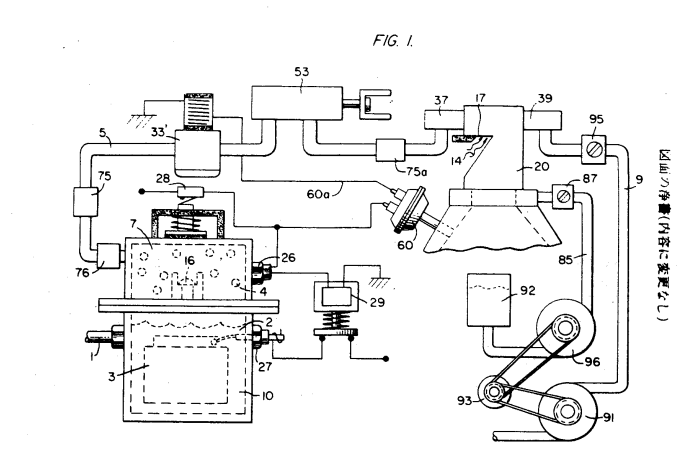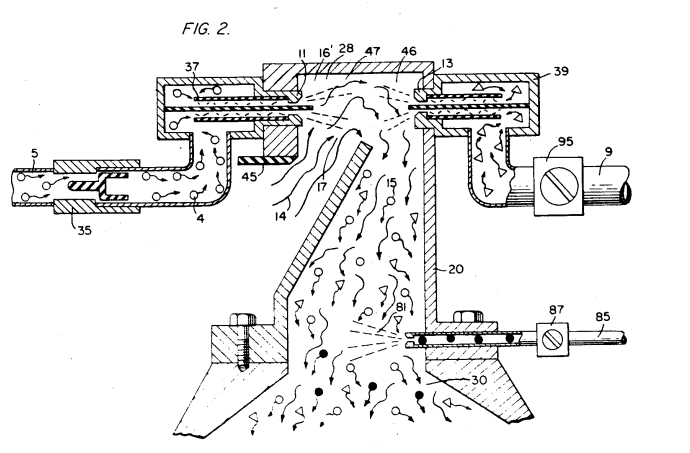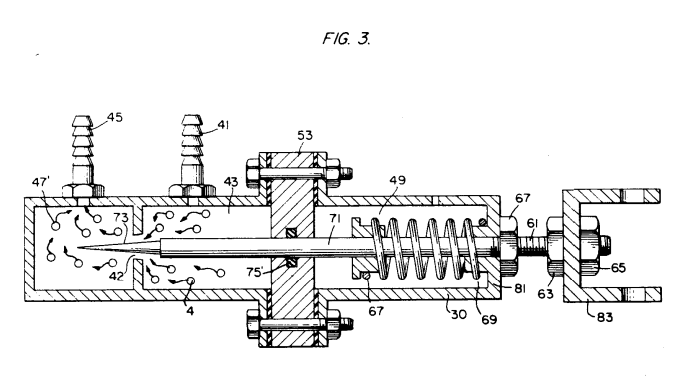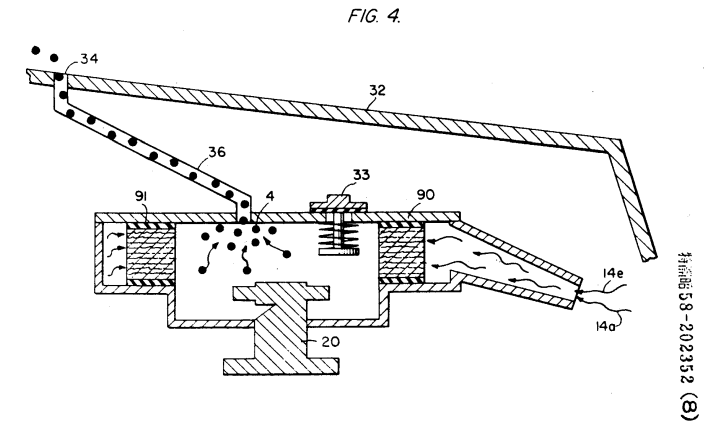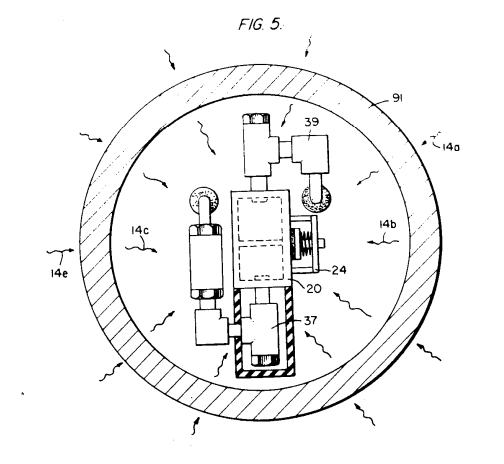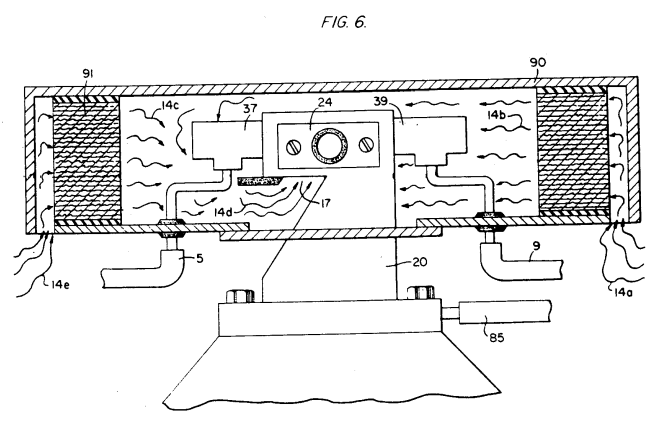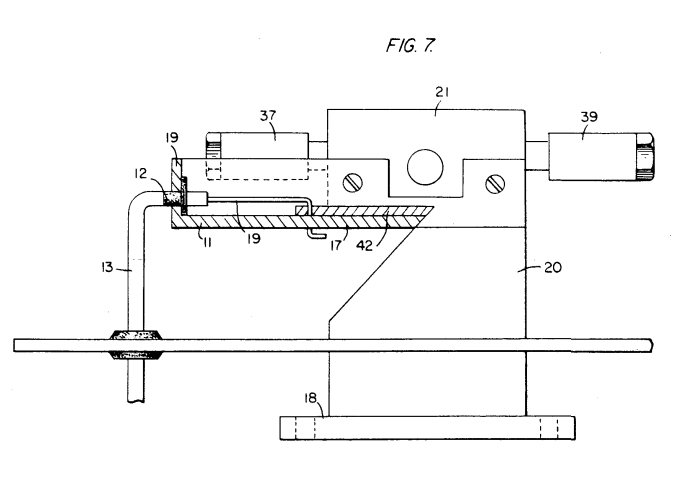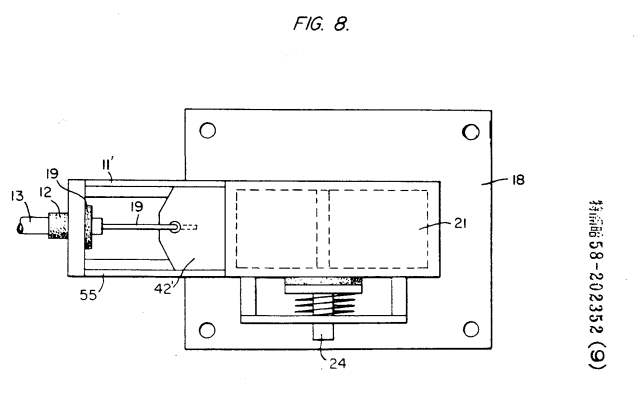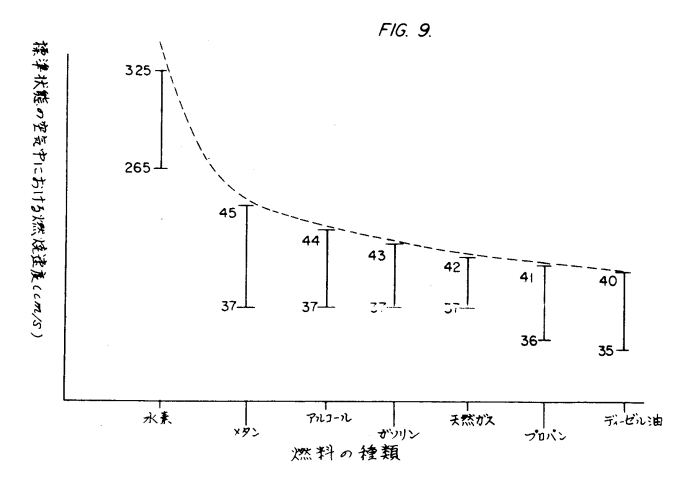JP 58-202352 - Hydrogen Gas Injection Apparatus for Internal Combustion Engine
Japanese Patent Office (JP)
Publication Number: JP 58-202352 (A)
Publication Date: November 25, 1983International Classification (Int. Cl.): F 02 M 21/02
Application Number: JP 258-23867
Filing Date: February 15, 1983
Priority Claim: US February 17, 1982 (US) 349185Title: Hydrogen Gas Injection Apparatus for Internal Combustion Engine
Applicant:
Stanley A. Meyer
3792 Broadway, Grove City, Ohio, USAInventor:
Stanley A. Meyer
3792 Broadway, Grove City, Ohio, USAAgent:
Law Firm: Nakamura & Associates (with 4 additional attorneys)
PDF Download: SMeyer-JP58202352A.pdf
Scope of the Claims:
(1) A housing for storing compressed gas, wherein the gas includes a natural gas mixture. This housing contains a pair of electrodes with non-conductive properties. These electrodes are arranged to apply direct current or high-voltage electric charges to the gas mixture in the housing. The system is designed to dissociate molecules of hydrogen and oxygen from the gas molecules. The residual gas is then collected and stored.
A method to extract hydrogen gas from the housing by controlling the pressure within the housing.
A mechanism to collect hydrogen gas generated within the housing through an outlet connected to the fuel combustion chamber.
A method to separate undesirable gas components from the gas generated, and return the remaining components to the housing.
A system to control the air-fuel mixture entering the combustion chamber by adjusting the volume of undesirable gas released.
(2) A device as described in (1), wherein the housing contains a variable valve to control the air pressure and the amount of hydrogen gas introduced to the combustion chamber.
(3) A method for separating hydrogen gas and oxygen gas within the housing, and transferring the gas through separate outlets.
(4) A system to use the separated hydrogen gas in combination with another fuel to create an air-fuel mixture suitable for combustion.
(5) A combustion device, wherein the rod mechanism connected to the tape-equipped rotating structure described above, and the port to which the tape-equipped rotating structure is connected, causes the displacement of said tape-equipped rotating structure.
(6) The gas mixture chamber, where it includes a hydrogen-oxygen gas injection device and also a non-explosive gas mixing device.
(7) The gas mixture chamber includes a trapping area in the upper and lower sections, and the hydrogen-oxygen gas mixture portion is stored in the trapping area.
(8) The surrounding air intake device includes a control mechanism, and a combustion device as described in claim (1), wherein the surrounding air and non-explosive gas mixture are directed into the chamber.
(9) ???
(10) The surrounding air intake device in claim (8), which allows the combustion chamber to intake oxygen and hydrogen gas into the trapping area for combustion.
(11) The combustion device in claim (1), wherein a control device is provided to connect the burner and the hydrogen-oxygen gas supply device, which controls the on/off operation of the burner to control the flow of gas.
(12) The combustion device in claim (1), wherein the control mechanism connected to the burner is pressure-regulated.
(13) A housing that surrounds the mixture chamber, having a first opening in the housing for air intake and a second opening in the housing to allow hydrogen gas captured in the mixture chamber to release into the atmosphere.
(14) The upper part of the hydrogen-oxygen gas generator includes a sealing area, wherein the hydrogen gas contained in it is stored at a predetermined amount.
(16) The method for connecting hydrogen-oxygen gas to the mixture chamber includes a directional valve as stated in claim (11) of the combustion system.
(17) The method for connecting hydrogen-oxygen gas to the mixture chamber, which includes an emergency device as stated in claim (11) of the combustion system.
(18) The gas burner described in claim (11) is an internal combustion engine, and the non-combustible exhaust gases are expelled through the engine's exhaust as stated in claim (11).
(19) The oil supply device, the multiple oil supply sources, and the oil spray are equipped as stated in claim (10) for supplying oil to the mixture chamber.
This invention relates to a new combustion device.
In U.S. Patent No. 4,302,807, issued on September 6, 1983, a hydrogen generation system is described, where water is dissociated into hydrogen and oxygen gas. The system passes water between two electrically non-conductive and non-oxidizing metallic plates, applies direct current voltage/electric fields of low energy to the water, causing the water molecules to dissociate into hydrogen and oxygen atoms. This process involves non-combustible, non-reactive electrolysis at low voltages, encouraging sub-atomic reactions. This system includes mechanisms that can separate hydrogen and oxygen gases from the water.
Additionally, in U.S. Patent No. 4,724,644, issued on May 5, 1987, a hydrogen-air gas treatment device is described. This patent discusses a system where hydrogen gas, along with non-combustible exhaust gases, is controlled to prevent combustion.
The "Hydrogen Air Purification Processing System" (Hydrogen Air-dation Processor System) is utilized to measure, mix, and compress gases. This system employs a rotary-type mechanical gas conversion device. When gas is converted, air is passed through an open-volume combustion chamber, and impurities and other substances from the existing gas are removed. Following this, the system adjusts the ratio of non-combustible gases and ensures the correct mixture by removing impurities, preparing the exact quantities of hydrogen gas and other combustible gases needed. In this manner, the system creates a new synthetic gas mixture. The volume of this synthetic gas is then measured, and the appropriate gas mixture for combustion is determined to ensure the correct amount of water gas is introduced to the combustion chamber. Additionally, the rotary mechanical gas conversion device regulates the exact volume of the synthetic gas to be produced.
The hydrogen-air gas treatment device described in U.S. Patent is a highly useful and practical system for a variety of purposes. Additionally, other U.S. Patents related to this system demonstrate a unique and simple hydrogen gas generation system.
This invention was filed on October 8, 1984.
In U.S. Patent No. 3,594,945, a mechanically operated device that can be applied to a combustion device has been disclosed. This combustion device is useful, for example, in the operation of a piston engine in an automobile. This disclosure relates to a hydrogen gas generator device that produces hydrogen and non-combustible gases (e.g., oxygen and nitrogen). The water gas and the non-combustible gases generated by the water gas production apparatus pass through a purification process and are then mixed together with non-combustible gases and air that are drawn into the combustion chamber by a control device. Following this, the mixed gas enters the combustion chamber where it is ignited. After combustion, the gas enters the mixing chamber, where the non-combustible gases are combined with flammable gases and vapor. As this occurs, a combustion process is formed, and this patent describes the practical application of this system, along with other examples of usage.
Now, the purpose of the current invention is to provide a combustion device that uses hydrogen and non-combustible gases.
The objective of this invention is to provide a combustion device that controls the temperature by regulating the mixture of hydrogen and non-combustible gases in advance.
Other objectives and features of the present invention will become apparent from the following description.
The preferred embodiment of the present invention is a combustion device that uses hydrogen gas, particularly in an automotive engine that operates the piston.
The hydrogen gas generator device used in this invention produces hydrogen gas, which is mixed with non-combustible gases and sent to the combustion chamber. Additionally, air is introduced into the mixing chamber, where it is further mixed with the hydrogen gas. This mixture is controlled in such a way that the combustion process is stabilized, and the combustion of hydrogen gas is controlled to adjust its burning speed and emission amount. By regulating the flow of hydrogen gas into the combustion chamber, and controlling the mixing of air and other gases, the combustion process can be optimized, and non-combustible gases can be utilized efficiently.
The hydrogen gas generator supports the ignition source for the combustion process.
The hydrogen gas generator includes a tank and is equipped with a pressure detection switch in the combustion chamber, as well as a position switch operated by other devices. Additionally, it has an electrical switch that operates when activated from a position different from other functions.
The simplified structure incorporates safety valves and emergency shutdown devices. This combination forms a complete system that can safely convert a hydrogen gas mixture into fuel for automotive engines, gasoline engines (or other fuel engines).
Below, the diagrams are used to explain the present invention.
FIG. 1 illustrates the overall system of gas mixing and combustion in a combustion engine, particularly an automotive engine.
FIG. 2 shows the hydrogen supply source, which corresponds to the hydrogen gas generator 10 mentioned in the applicant’s prior U.S. patent publication. The device 10 contains storage components.
In FIG. 2, components related to the plates disclosed in the prior U.S. patent application are clearly displayed. At point 8 in FIG. 3, the direct current voltage/flow regulator is shown.
The upper part of the device 10, portion 7, is the hydrogen storage section, where the appropriate amount of hydrogen is kept under pressure.
In this way, during the start-up, water vapor generated by the hydrogen gas is supplemented with consumed water. The generator device is equipped with a conventional water replenishment pump. Additionally, the exhaust gas generator is constructed similarly to the one described in the applicant's previous patent application.
Safety valve 28 releases the excess gas generated. Additionally, switch 26 activates the hydrogen gas generator when the gas volume decreases, maintaining the required gas pressure level by operating the pressure switch.
The generated hydrogen gas is sent one way through the check valve 16 and pipe 5 to the gas mixing chamber 8, where it mixes with the combustible gas and is sent to the combustion chamber 9 through the supply pipe.
However, if the pipe 75 malfunctions and causes the hydrogen gas generator 10 to disconnect, a spark could ignite and trigger combustion in the generated hydrogen. In such cases, the spark is suppressed, and the combustion is extinguished.
As explained with reference to figure 2, the hydrogen gas is sent through pipe 5, and the combustible gas is sent through pipe 9. Then, the mixed gas is conveyed to the mixing chamber 20 via the ejector or other mixing mechanisms, where atmospheric air intake section 14 is also set up.
The hydrogen gas passes through nozzle 11, through spray 16, and reaches the trap area 46 within the mixing chamber 20. Nozzle 11 is equipped with a small hole at the opening of the cooling device 37 to prevent any sparks from causing a flashback.
The non-combustible gas passes through nozzle 13 and is injected into the trap area 47 in the mixing chamber 20 as jet spray 17. The ignition device 39 works in conjunction with the emergency valve 37.
When the gas is generated, it activates the combustion in the combustion chamber. Additionally, the gas exhaust pipe within the exhaust system releases the non-combustible gas along with the exhaust gas, which ensures safe operation.
At first, oxygen and/or non-combustible gas can be supplied independently or simultaneously to ensure a constant supply. Furthermore, referring to figure 2, the trap area 47 for gas has a suitable size for the nearby section. When hydrogen gas is introduced into the air, the hydrogen rises and is captured within area 47. The size of area 47 ensures that, during the start of the combustion engine, the temporarily generated spark will collect a sufficient amount of hydrogen gas to ignite.
The introduction of hydrogen gas into the trap area 47 helps prevent ignition delays. Hydrogen gas rises at a much faster rate than oxygen (or non-combustible gas), rising at a rate three times faster or even more. This allows hydrogen gas to enter the trap area (liquid section) much quicker, making it easier to rise into the air, compared to other heavier gases.
In the configuration with the ejector system, hydrogen gas is strongly ejected downward toward the air intake section 15. At the same time, as hydrogen gas rises strongly upwards, it mixes thoroughly in the turbulence created by this combination of downward and upward flows.
Non-combustible gas and sealed air (oxygen) passing through passage 9 have a controlled ratio suitable for each engine. The amount of non-combustible gas is adjusted by regulating valve 45, and adjusting the amount of sealed air allows for the proper combustion mixture to be determined and maintained. The system ensures that non-combustible gas is controlled by the engine's exhaust gas, and the intake air volume is regulated according to the engine, thereby maintaining the non-combustible gas supply relative to the engine's acceleration.
The sealed air and non-combustible gas mixture becomes a carrier for hydrogen gas. That is, hydrogen gas is mixed with the sealed air/non-combustible gas combination. By adjusting the volume of hydrogen gas mixed with sealed air/non-combustible gas, the engine's revolution rate is controlled.
Referring to figure 3, the details of the control mechanism for regulating the combustion mixture is clearly demonstrated in paragraph 53.
Hydrogen gas 4 enters the system through gas inlet 41 and moves to tube 43.
Hydrogen gas passes through valve 43, enters chamber 43, and then goes through port 42 into chamber 47. The amount of gas flowing from chamber 43 to chamber 47 is regulated by controlling the opening of port 42.
The opening of the port is controlled by inserting pin 73 into the wedge-shaped groove. Pin 73 is fixed at the end of rod 71. Rod 71 passes through support 5, moves through housing 30, and reaches the manual driving mechanism 83 through manual control system 81.
Spring 49 holds rod 71 and pin 73 in place relative to the opening 42. When the mechanism 83 operates, pin 73 is pulled away from the opening 42, allowing more gas to flow from chamber 43 into chamber 47.
Stoppers 67 and 69 hold spring 49 in the default position. The fixed position of pin 73 relative to the opening 42 is connected to nut 13 attached to rod 61, which is fixed by stoppers 67 and 69. This mechanism controls the idle speed and regulates combustion under low-load operation by adjusting the size of the wedge.
Gas flows from chamber 43 to chamber 47. In the diagram, the air volume control device for regulating the amount of air sent to chamber 20 is illustrated. Plate 21 is attached to board 18, and its end is fixed to port 11. Control plate 42 is equipped with an automatic return spring. The position of control plate 42 relative to port 12 is controlled by the control device connected to lever 19. If an abnormal combustion condition occurs in chamber 20, safety valve 24 is activated.
As shown in Figure 6, when hydrogen gas passes through chamber 20 at high pressure, any water collected at filter 34 will be discharged through line 36, and the remaining hydrogen gas will be safely released into the atmosphere.
When an abnormal combustion condition is detected inside chamber 20, safety valve 33 is activated, and any hydrogen remaining is expelled from the system to prevent further combustion.
The gas control system illustrated regulates the flow of hydrogen (combustible gas) to the burner. In the case of a burner, a gas control valve 53 (gas inlet) is provided to regulate the flow of hydrogen gas to the burner. The details of valve 53 are explained in Figure 3. The air intake section 14, as explained in Figure 8, is controlled by an air control valve 55 that regulates the flow of air. This mechanism allows proper air supply to the burner.
To maintain a stable pressure in the hydrogen storage tank during the engine's on/off operation, the gas control valve works in conjunction with vacuum-operated switch 33'. This ensures stable gas supply during startup and normal operation, as well as during periods when the engine is running.
Switch 33' operates in connection with vacuum control switch 60, which is activated when the engine is in operation. If the vacuum falls during engine idle, switch 33' responds accordingly.
When switch 60 is released, switch 33' is activated, stopping the flow of hydrogen gas to the control valve 53. When safety valve 28 detects a low pressure, solenoid 29 is activated. The solenoid works through pressure switch 26 and restricts the backflow of hydrogen gas by controlling the pressure at the rear end of the hydrogen generator. When the solenoid 29 is activated by electric power, hydrogen gas flows out of control valve 16, through pipe 5, and is supplied to the burner.
The differential pressure of the hydrogen gas relative to the gas mixture chamber is approximately 0.5 to 0.7 kg/cm² (30 pounds per square inch or 5 psi). When the hydrogen generator 10 reaches a critical level, pressure switch 26 starts regulating the pressure supply to the hydrogen generator. If the pressure exceeds a certain level, safety valve 28 will activate, and the power supply will be shut down to prevent any hazards, shutting down the entire system for safety.
Figure 8 shows a four-stage enclosed combustion system with an upper lid separating the internal combustion chamber.
In this preferred embodiment, the apparatus is equipped with housing 90, which contains the air intake sections 14a and 14b. The air passes through filter 91 attached to sections 14b and 14c and then flows into the intake section 14d of the mixing chamber 20. Water flows through pipe 5 and passes through cooling device 37 before entering the mixing chamber 20. The non-combustible gas from the combustion chamber passes through cooling device 39 and then enters the mixing chamber 20.
Note: Figure 8 illustrates the mechanical details of the components inside mixing chamber 20, which are also shown in another diagram.
Returning to Figure 3, in this diagram, valve 93, which is activated by the engine, regulates the flow of non-combustible gas through passage 91. Attached to valve 93 is filter 95, and also a lever 98 that is mechanically linked to throttle 92. Additionally, pipe 87 connects to mixing chamber 20, regulating the flow of non-combustible gas during engine operation.
The oil supply valve 85 regulates the flow of the oil atomizer, delivering it into chamber 20 for combustion.
Now, examining the characteristics of hydrogen gas, the system's operation, and safety, several research papers provide important insights. One such paper is "Selected Properties of Hydrogen (Engineering Design Data)" published in February 1981 by the National Bureau of Standards.
This research primarily discusses the high cost of hydrogen generation and its challenges. Additionally, the papers explain that hydrogen gas poses safety concerns when used in industrial applications, especially regarding its low ignition energy.
Figure 9 compares the ignition energy of hydrogen with that of other fuels such as alcohol, propane, butane, methane, and diesel oil. It demonstrates that hydrogen's ignition energy is significantly lower than that of other fuels.
In order to achieve a high combustion speed with hydrogen gas, traditional researchers have not considered hydrogen as a replacement fuel. Furthermore, even if engines were designed to handle such high combustion speeds, safety concerns regarding explosion hazards make it impractical for commercial use.
This invention, as mentioned earlier, solves the above-mentioned problems when hydrogen is used in conventional commercial engines. First, by referring to the U.S. Patent documentation, the cost of hydrogen gas production is low. Additionally, as shown in the prior art, hydrogen gas combustion is controlled, thus allowing safe use. The U.S. Patent documentation explains that this control is achieved through methods, showing a feasible and practical approach.
Thus, this invention offers a suitable application for industrial engines using hydrogen fuel by solving the previously noted safety concerns.
A practical device for applying hydrogen gas generators to combustion engines has been developed. This invention regulates the flow of hydrogen gas in a controlled manner, sends the reduced hydrogen gas mixture to the combustion chamber, and minimizes the combustion speed. Thus, using this device ensures the same level of safety as when using other fuels.
Furthermore, as an experimental advantage, this device can be adapted to work with any type of internal combustion engine, regardless of its design or fuel type, by operating exclusively on hydrogen gas. Hydrogen gas, unlike chemical compounds, is very low pressure and lightweight. The combustion speed of hydrogen gas is lower than that of typical fuel combustion systems. Above all, all the previous considerations, with safety features in mind, guarantee that this system operates safely, even when using hydrogen gas in conventional automatic systems.
The above explanation applies equally to both combustible and non-combustible gases. The system ensures safety by controlling the gas flow in a simple and safe manner.
As mentioned earlier, regarding the hydrogen storage area labeled as region 7, the term "storage" does not imply long-term storage in the academic sense. In fact, this region is more accurately described as a temporary retention area. Region 7 holds sufficient hydrogen for the initiation of combustion when needed.
Other applications and examples related to this invention have been explained in the previous sections. It is important to understand that the described invention is not limited to these technical boundaries but can undergo various modifications within the scope of the claims.
Explanation of Figures
Figure 1 is a block diagram showing a general practical embodiment of the device described in this invention.
Figure 2 illustrates a special hydrogen radiation device featured in the practical embodiment of the invention.
Figure 3 shows a configuration diagram of a fuel injection control device, which is also part of the special embodiment of the invention.
Figure 4 depicts the invention applied to an automatic combustion system using non-combustible fuel.
Figure 5 shows the plan view of the fuel injection device used in this invention.
Figure 6 shows the side sectional view of the fuel injection device of this invention.
Figure 7 shows the side sectional view of the fuel mixing chamber used in this invention.
Figure 8 shows the sectional view of the fuel mixing chamber, which includes an air intake.
Figure 9 is a graph illustrating the combustion efficiency of various fuels for reference.
List of parts:
1... Water supply source 3... Plate (injector plate) 4... Hydrogen gas 7... Hydrogen storage area 10... Hydrogen gas generation device 20... Gas mixing chamber
Procedural Amendment Document (Form)
Date: Showa 58 (1983) June 30Patent Office Notice:
Case Number:
Showa 58 Year Application No. 23667Title of the Invention:
Internal Combustion Engine Hydrogen Gas Injection DeviceApplicant (Person making the correction):
Relationship to the case: Applicant
Name: Stanley A. MeyerAgent:
Address: Tokyo, Chiyoda-ku, Kanda-Jinbocho 3-1-1 (Phone: 211-8741)
Name: Attorney Nakamura (Attorney Number: 58906)Date of Correction Order:
Showa 58 (1983) May 31Scope of the Correction:
Entire DocumentContent of the Correction:
As indicated in the attached document
[Corrected to read: Internal Combustion Engine Hydrogen Gas Injection Device]
|
|
|
|

